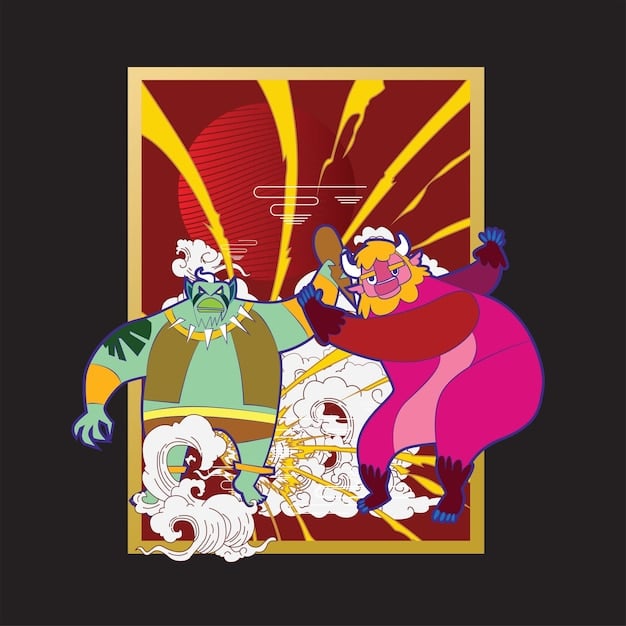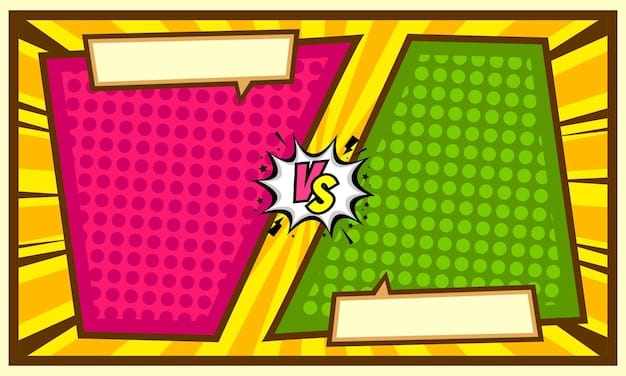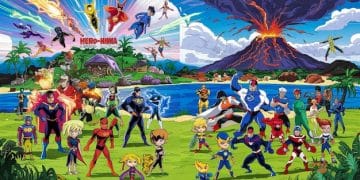Manga Release Impact: Shonen Manga’s Influence on the US Comics Market

Manga release impact has dramatically reshaped the US comics market, with new *shonen* manga releases driving significant growth, influencing artistic styles, and diversifying readership demographics within the American comic book landscape.
The landscape of the US comics market is constantly evolving, but one of the most significant recent shifts has been the increasing influence of Japanese manga, particularly new *shonen* releases. The manga release impact is undeniable, transforming reader preferences, artistic trends, and the overall industry narrative.
Understanding the Rise of Shonen Manga in the US
The popularity of *shonen* manga in the United States has surged over the past decade. Several factors contribute to this rising trend, including increased accessibility through digital platforms, the global spread of anime adaptations, and the unique storytelling conventions *shonen* manga offers.
Accessibility through Digital Platforms
Digital platforms have made manga more accessible than ever to US readers. With services like Viz Media’s Shonen Jump app and Crunchyroll, fans can instantly access the latest chapters of their favorite series. This easy accessibility has fueled the expansion of manga’s readership.
Anime Adaptations and Global Appeal
Many *shonen* manga titles are adapted into anime series, which further boosts their popularity. Shows like *Attack on Titan*, *My Hero Academia*, and *Demon Slayer* have gained massive international followings, introducing new fans to the source material. The global reach of anime greatly enhances manga sales and readership in the US.
- Cultural Exchange: Anime series act as gateways to Japanese culture, spurring interest in manga.
- Visual Medium: Anime makes manga more visually digestible for new audiences.
- Community Building: Shared viewing experiences of anime create online communities that promote manga readership.
The growth of *shonen* manga in the US is supported by digital accessibility, anime adaptations, and the unique storytelling conventions that appeal to a broader audience.
The Economic Impact of Manga Releases on the US Comics Industry
The economic impact of manga releases on the US comics industry is considerable. Manga sales have experienced significant growth, often outperforming traditional comic books. This shift has led to increased competition and revenue redistribution within the market.
Sales Growth and Market Share
Manga sales have steadily increased over the years, capturing a larger share of the US comics market. According to recent reports, manga sales have surpassed those of mainstream superhero comics in certain categories and demographics. This growth demonstrates manga’s increasing economic relevance among avid comic readers in the US.
Competition and Revenue Redistribution
The popularity of manga has introduced competition for established comic book publishers. Smaller publishers specializing in manga have emerged, and larger publishers are increasingly licensing manga to diversify their offerings. This competition has led to a redistribution of revenue as manga gains a more significant portion of overall sales.

- Increased Licensing Agreements: More publishers are licensing manga titles to capitalize on their popularity.
- Marketing and Promotion: Publishers are allocating more resources to marketing and promoting manga releases.
- Adaptation Strategies: Comic book publishers are adopting manga storytelling styles to attract new readers.
The economic influence of manga releases includes notable sales growth, greater market share, and increased competition that affects revenue distribution. This impact forces traditional comic book publishers to adapt and innovate to stay competitive.
Influence on Artistic Styles and Storytelling Techniques
Manga releases have had a profound influence on the artistic styles and storytelling techniques used in American comics. Artists and writers are increasingly incorporating elements of manga into their work, resulting in a hybrid style that appeals to a broader audience.
Incorporation of Manga Elements in American Comics
Many American comic artists are adopting manga-inspired character designs, panel layouts, and visual cues. This hybridization of art styles helps to attract a new generation of readers familiar with manga aesthetics. Elements such as exaggerated expressions and dynamic action lines are now common in many US-produced comics.
Storytelling Innovations
Manga storytelling techniques, too, are making their way into American comics. Concepts like extended character arcs, focus on emotional depth, and intricate world-building are being embraced by writers looking to add complexity and appeal to their narratives.

- Dynamic Panel Layouts: The use of larger and more varied panel sizes to create a sense of movement and energy.
- Emotional Storytelling: Exploring complex character emotions and relationships in depth.
- Character Development: Focus on long-term character arcs and personal growth.
The impact is visible in the blending of art styles and storytelling approaches, enriching the artistic and narrative landscape of American comics.
Changing Demographics: Who Is Reading Manga in the US?
The demographics of comic book readers in the US are changing, largely due to the growing popularity of manga. Manga has attracted a younger and more diverse audience to the comics market, including a higher percentage of female readers.
Attracting Younger Readers
Manga appeals to younger readers seeking stories that resonate with their experiences and interests. The relatability of characters, the focus on themes like friendship and perseverance, and the immersive storytelling all contribute to its appeal among teenagers and young adults.
Increased Female Readership
Unlike traditional superhero comics that have historically skewed male, manga has successfully attracted a significant female readership. Series with strong female characters, complex relationships, and diverse themes draw in readers who may not have previously engaged in the comics market.
The influence of manga is extending beyond superficial aesthetics, integrating into core storytelling attributes and affecting the target audience.
Challenges and Opportunities for US Comic Publishers
US comic publishers face both challenges and opportunities as manga continues to grow in popularity. Adapting to changing reader preferences, diversifying content offerings, and exploring collaborations are key to navigating the evolving market.
Adapting to Changing Reader Preferences
US publishers must adapt to evolving reader preferences by incorporating elements that make manga popular, such as diverse storylines and character designs. Understanding what drives the appeal of manga can help publishers create content that captures a broader audience.
Diversifying Content Offerings
Diversifying content offerings means exploring genres and formats beyond traditional superhero comics. Offering manga translations, creating original manga-inspired series, and licensing international titles can cater to a wider range of tastes.
- Partnerships: Collaborating with manga publishers and creators can bring fresh perspectives.
- Innovation: Experimenting with new storytelling formats to cater to diverse audiences.
- Cultural Sensitivity: Promoting diverse cultural representation in comics.
The growth of manga in the US presents US comic publishers with both challenges and significant opportunities. Adapting to reader preferences, diversifying content and fostering collaborations can lead to sustained success in an evolving market.
The Future of Manga and American Comics
The future of manga and American comics looks intertwined, with each influencing the other in new and exciting ways. Cross-cultural collaborations, innovative storytelling formats, and increased diversity are likely to shape the industry.
Cross-Cultural Collaborations
Collaborations between Japanese and American creators are becoming more common, leading to unique hybrid projects that blend the best of both worlds. These partnerships can result in innovative and culturally rich stories that appeal to a global audience.
Innovative Storytelling Formats
Publishers are experimenting with new storytelling formats such as digital comics, webcomics, and vertical scrolling comics to cater to how readers consume content on their devices. These formats offer unique opportunities for creativity and reader engagement.
- Digital Platforms: Embracing digital platforms to reach a wider audience.
- Cultural Exchange: Promoting the exchange of ideas and creativity between different cultures.
- Reader Engagement: Actively engaging readers through social media and online communities.
The future holds potential for collaborations and evolving storytelling methods that will propel the comics industry into a new era, making it more accessible and appealing.
| Key Point | Brief Description |
|---|---|
| 📈 Market Growth | Manga sales are increasing, capturing a larger share of the US comics market. |
| 🎨 Art Influence | American comics are adopting manga-inspired styles and storytelling techniques. |
| 👥 Changing Demographics | Manga attracts a younger and more diverse audience, including more female readers. |
| 🤝 Collaborations | Cross-cultural collaborations between Japanese and American creators are on the rise. |
FAQ Section
*Shonen* manga gains popularity due to its accessible digital platforms, engaging anime adaptations, and unique storytelling conventions that appeal to a broad demographic.
Manga’s increased sales have created competition within the market, redistributing revenue as smaller publishers specializing in manga emerge and grow their market share.
American comics are increasingly adopting manga-inspired designs, dynamic panel layouts, and storytelling techniques focused on emotional depth and extended character arcs.
*Shonen* manga typically attracts younger and more diverse audience to the comics market, successfully engaging female readers who traditionally were less present in the comics scene.
A major challenge for US publishers is the necessity of adapting both to new reader preferences and diversifying content to include innovative stories and appeal to broader populations, including licensing international titles.
Conclusion
The growing popularity of *shonen* manga in the US has brought about significant changes in the comic market. Its effects on sales trends, artistic styles, and audience demographics are noteworthy and continue to shape the industry’s trajectory. Adaptability and innovation will be key for publishers navigating this evolving landscape.





